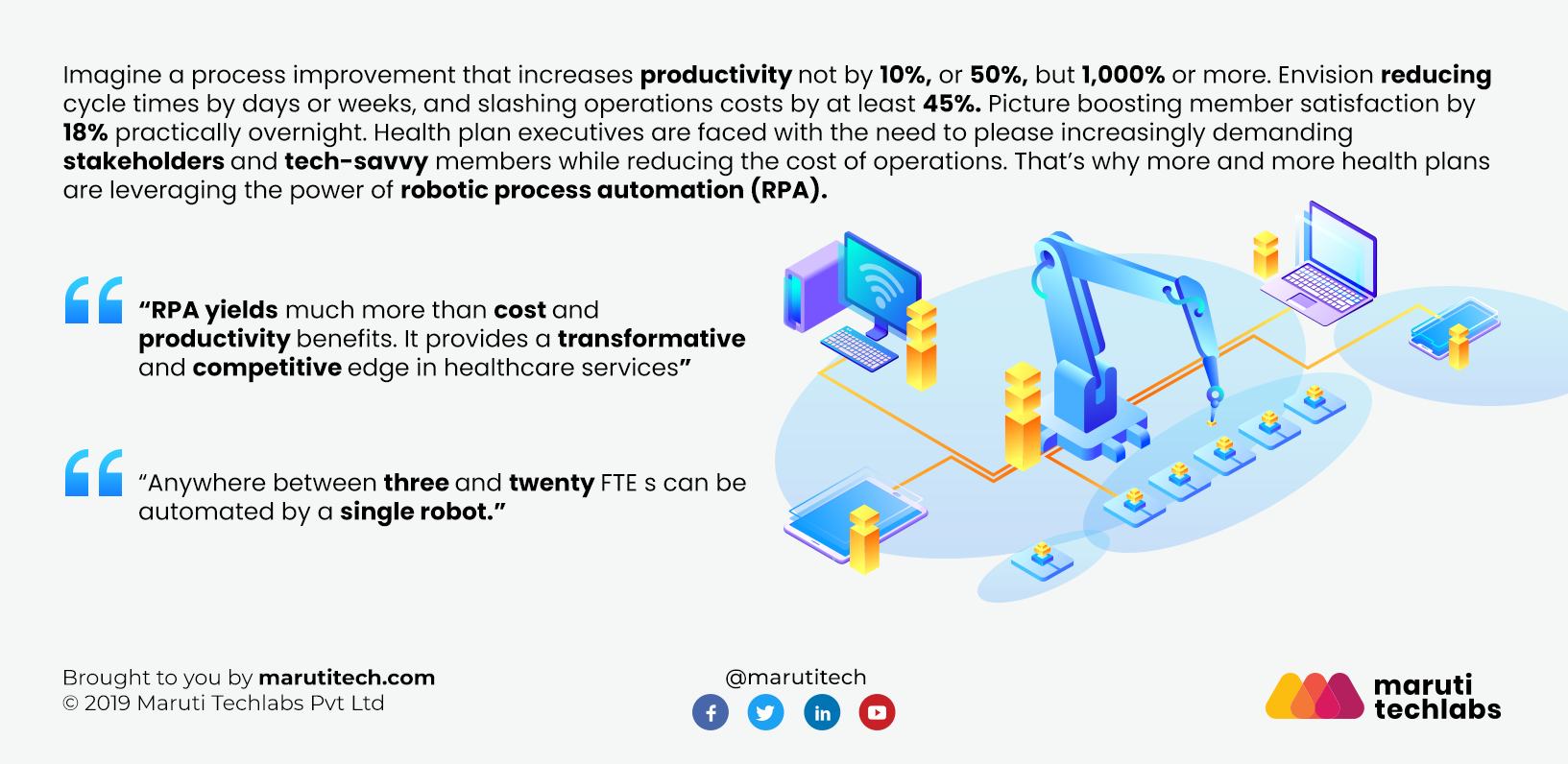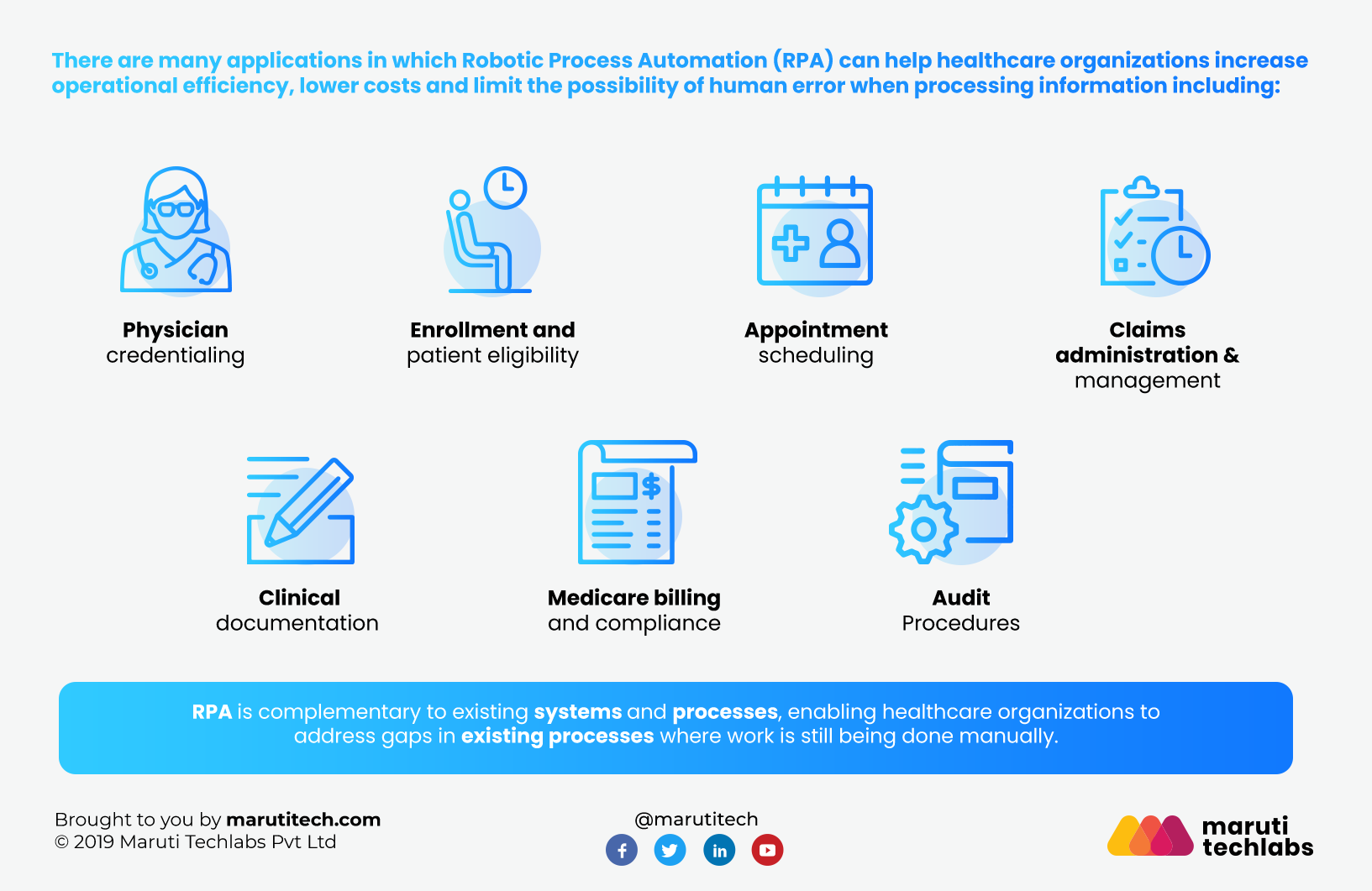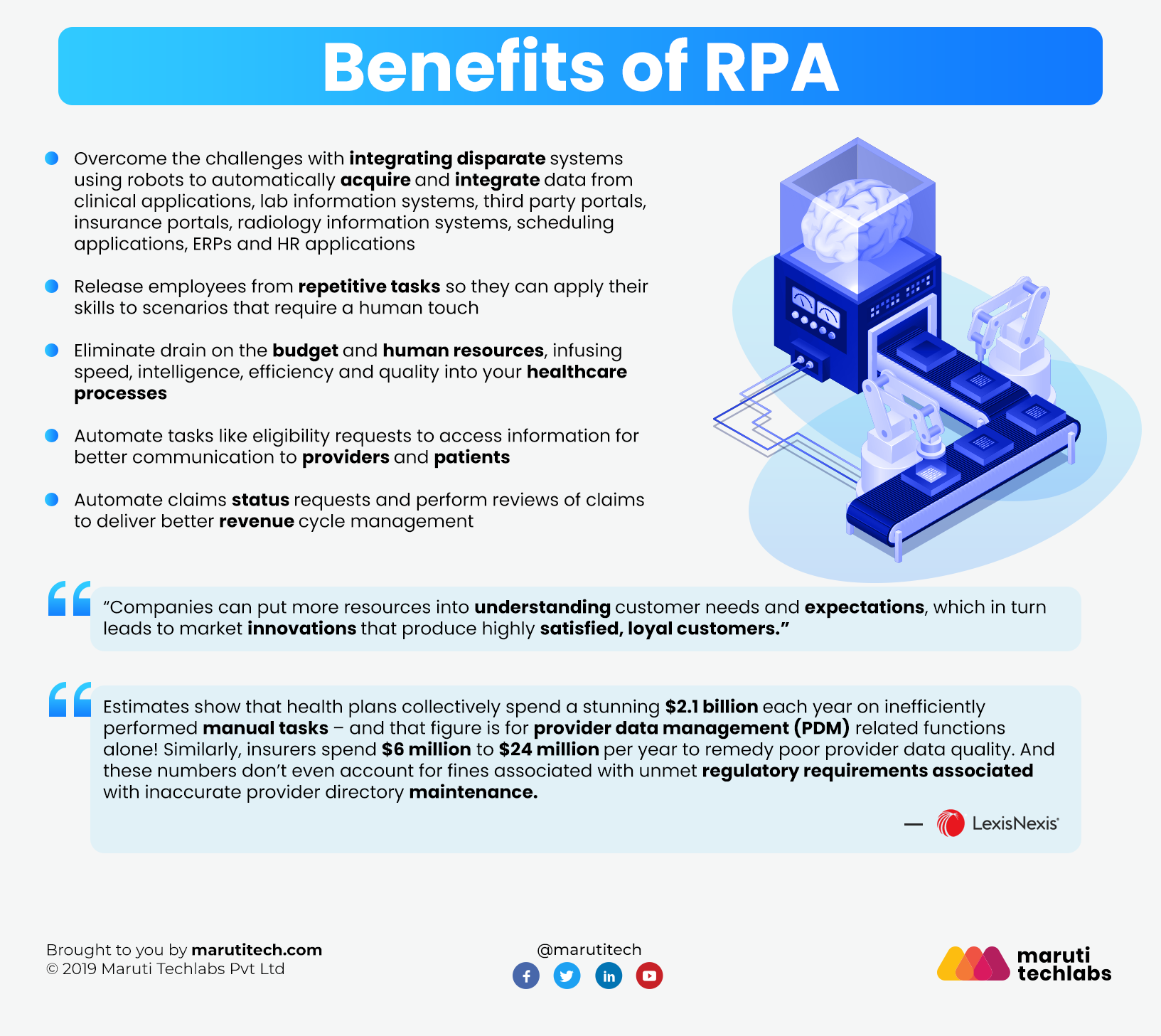

RPA in Healthcare:The Key to Scaling Operational Efficiency






Think of the data and information collected and processed by healthcare organizations on a daily basis. It includes data from various internal and external sources such as lab information systems, clinical applications, third-party portals, radiology information systems, insurance portals, scheduling applications, HR applications, and ERPs.
Also, integrating the flow of information across all these channels is a tedious and complicated job. Unfortunately, most of the healthcare businesses rely on human intelligence for this labor-intensive task, which increases the consumption of resources and reduces efficiency.
This is where Robotic Process Automation in Healthcare comes into the picture.
Robotic process automation, or RPA, can virtually automate any repetitive and manual task, critical to the functioning and processing of healthcare. It can encourage a new workforce because of empowerment in terms of intelligent tools extracting relevant information from several sources, partner ecosystems, EHRs, finance systems, payer portal systems, and accounting systems.
RPA can help the healthcare industry reduce costs, limit the occurrence of errors, and improve operational efficiency. In this article, we will discuss the scope, uses cases, and benefits of smart automation in healthcare.

Studies estimate that healthcare industry collectively spends a stunning $2.1 billion each year on poorly performed and error prone manual tasks around provider data management alone! Likewise, insurance companies spend somewhere between $6 million to $24 million annually to rectify poor provider data quality.
The systems in the healthcare domain that can benefit from RPA are highly inefficient, so much so that it has started impacting every aspect of the industry. From PDM and claims operations to customer support and billing. Every manual process has inefficient functioning, errors, and inaccurate data transfer.
Even though we can anticipate the financial losses occurring due to operational inefficiencies, it is hard to ascertain the exact costs when considering the inefficiency caused when these systems are not automated. This means that the actual value can be much more than our expectations.
Many research reports have revealed that in the following decade, more than 50% of the interactions will be automated through RPA. This also means that healthcare and other providers that don’t keep up with the industry trends will face financial downfall eventually. Their customer loyalty will reduce, customer experience will decline, and competitive advantage will suffer.
Ineffective healthcare systems still depend on manual tasks and processes, which are unsustainable and weak. RPA or robotic process automation can reduce unproductive processes and tasks by automating complex actions based on judgment. RPA can further offer a seamless execution of front office tasks such as:
Across the globe, healthcare providers execute multiple tasks, like claims management, billing, patient onboarding, report management, data management, and prescription management. Sadly, all these activities are manually handled with the help of off-the-shelf systems. Needless to say, this approach is extremely time-consuming, tedious, and error-prone.
Additionally, healthcare laws, regulations, and procedures keep updating regularly, meaning the system also needs to change and adjust to the requirements. However, if healthcare providers fail to achieve this, the outcome is usually dreadful, often seen in the form of compliance penalties and fines.
According to the Institute for Robotic Process Automation (IRPA), RPA in healthcare or automation in healthcare can improve workflows by automating rule-based tasks and processes. The bots used for automation can offer storage, data manipulation, process transactions, and system calibration abilities. Above all, automation in healthcare can improve results and reduce system errors caused due to poor functioning and manual processing.
Elucidated below is a list of applications where RPA can assist a healthcare organization in increasing operational efficiency, and limit the possibility of human error –

It is not uncommon for patients to book health appointments online, and it is also not unusual for healthcare providers to manage it manually. Think of all the hard work the provider has to put in. From the collection of personal patient information to diagnosis details and insurance policy number, everything is labor-intensive.
Also, scheduling and managing these appointments according to the availability of the doctor, and the patient is another herculean task altogether.
For example, whenever a patient books an appointment, the hospital staff has to ensure that the doctor concerned has enough time to accommodate the patient’s requirements. If not, another schedule should be suggested to the patient immediately. If the doctor gets busy with another major case at the time of the appointment, the provider is expected to inform the patient beforehand.
The point being made here is that scheduling and management of patient appointments is no cake-walk. It requires much effort from the hospital staff and the back-end team handling the online booking portal.
Automation in healthcare can eliminate these concerns. Firstly, you can start by automating the collecting of data from the patient. Using this data and the schedule of the relevant doctor, the RPA bots can offer appointment schedules to the patient. Once the appointment is booked, the bot will record the schedule in the database and remove that appointment slot. All this is achieved automatically.
If in case the doctor is busy with something else, the staff just has to update the schedule of the doctor. The bot will automatically intimate one or multiple patients of the same, thereby avoiding any hassle to the patient.
On an average day, if a healthcare provider receives X number of patients, the hospital staff is expected to prepare the bills of all these patients. It can include doctor’s consultation, test fees, wardroom costing, and several other costs incurred by the different patients.
Now, compiling this information can still be hassle-free if we define X as 2. But, if X is a large amount, it is not possible to calibrate the financials without making errors. Once errors find their way into the system, it disrupts the flow of various activities.
Here, automation in healthcare can automate the billing process. Once the structure is programmed in the bot, it will be able to generate automated bills in line with the services offered to the customers. The accuracy will improve, and human errors will reduce to a great extent. Further, since there are fewer errors in the system, healthcare providers will be able to reduce payment delays and financial loopholes.
It is estimated that almost 91.2% or 294.6 million Americans have health insurance coverage or policies. The claims management of this policy becomes the responsibility of the healthcare provider, which includes processes such as data input, processing, evaluation, and dealing with appeals. The entire process, if handled manually or using a generic software often proves to be highly inefficient and error-prone. Additionally, more than 30-40% health insurance claims can be denied because of non-compliance of regulations.
Gathering this data, storing it in the system, and processing it without errors is not as simple as it sounds. With legacy systems or traditional management workflows, it is very difficult to remove errors and or maintain compliance regulations. Hence, to ensure better error-free execution and compliance management, proper technical support is required.
Here, intelligent automation can reduce errors and speed up the process. The bots can automatically populate insurance claims fields and apply the relevant regulatory laws on the same. Once the claim document is prepared, the claim filing can be started. Due to the error-free document submission, it becomes easier for the healthcare provider to speed up the claims management.
Usually, whenever a patient is discharged from the hospital post-treatment, they are expected to follow post-medication and healthcare regimes. However, often, it’s likely for the patient to not follow the post-hospitalization medication responsibly.
With RPA in healthcare, the bots can deliver the exact discharge and post medication guidelines. The bots can also be programmed to send a notification at the right time to inform the patient of the schedule, appointments, and tests. Additionally, using these bots, patients can contact doctors for further assistance.
In the healthcare industry, an audit is a crucial task that happens from time to time. Whether it is to check the efficiency of patient services or to check the quality of safety procedures provided on the premises.
All these essential aspects are audited based on several objectives. Then, reports are generated, and the compliance structure is assessed. This is because errors in the system can lead to compliance issues, which doesn’t yield a very good outcome.
Here also, automation in healthcare can be utilized to automate and streamline the auditing process. While the bots can’t execute the complete audit procedure as that is still achieved by human auditors, they can, however, help in the recording of data and report generation. That is one less hassle that the auditor has to deal with
Based on these reports, the hospital staff can take appropriate measures, and accordingly, the reports will evolve or change. This automation also helps in detecting the source of non-compliance with the help of the tracking functionality.
The healthcare industry collects a massive amount of data on a daily basis. This data and information only keep increasing with the addition of new patients, procedures, and medications.
How is it possible for a healthcare provider to manually manage all this data, then?
Imagine a patient returning with a disease for which he was treated earlier. The doctor concerned may require the old data due to which the hospital staff may have to rummage through multiple registers and paperwork to find the same.
Even if this data is stored in the computer system in some form of excel sheet, it is not possible to extract it manually in a short amount of time. The efforts involved are just too rigorous.
RPA can directly capture this data at the time of the patient’s registration and save everything relevant to that particular patient. The hospital staff will also be able to extract the relevant data in minutes rather than hours, thereby improving the efficiency of the workflow.
Further, automation in healthcare bots will offer reports and insights, using which, it becomes possible to track the health conditions of patients, and their treatment. This will also allow for the customization of a treatment plan for individual patients.

Today, every individual wants personalized services, quick responses, and a seamless experience. When things are not right, these individuals want to connect with a real person to solve the issues. This is often a difficult task because there are so many backlogs which don’t allow human representatives to reach out to the patient immediately.
Automation in healthcare can eliminate this issue because a task that is accomplished by a human representative in more than 10 minutes can be performed in 2 minutes by the bot. The bots can integrate every system to create a unified platform for the customers. This means that customers can receive instant information and high-quality experience through bots.
The staff members can utilize this extra time in the execution of more strategic tasks, such as personalization of user services based on unique requirements, etc.
According to the Institute for Robotic Process Automation & AI, human professionals are more inclined to make at least 10 errors per 100 steps. This is because humans don’t want to execute repetitive tasks, as, over time, it gets boring. But RPA bots don’t get bored. They don’t judge the situation, and hence, are not affected by emotions. Therefore, bots can eliminate errors and improve efficiency because they are programmed to follow a particular action in a specific manner.
However, it is necessary to note that human intelligence in data analysis has no visible substitute. Tasks like these can only be achieved by a human specialist. So, bots are utilized to gather, extract, and process the data, which is then utilized by humans.
It is commonly believed that robots will eliminate real-world jobs. In reality, however, robots enhance human capabilities. Execution of repetitive, boring tasks only decreases the performance of human employees. When this task is taken over by a bot or RPA in healthcare, it becomes easier for human professionals to get involved in strategic, intelligence-based roles. This will also help human professionals in terms of career growth and consistent learning.
RPA helps streamlines most of the user-related activities. Even in a downturn, when you have to lay-off employees, bots can manage customer support and guidance to deliver a good experience at all times. Hence, with employee satisfaction, automation in healthcare also improves the quality of services offered.
Initiate by getting to assess and identifying where tedious and monotonous tasks hurt your organization. Start with identifying the opportunity, proceed with validating the opportunity, design the mode, and lastly deploy a pilot. Healthcare providers are finding software agents as a far more cost-effective option of accentuating or replacing platforms.
RPA in healthcare complements the existing systems, workflows, processes, and procedures. Through automation, it restructures lousy workflows and inferior execution methods. Once that is achieved, user services also improve, which leads to an increase in user satisfaction levels.
Want to find out how Maruti Techlabs can help you leverage smart automation services to increase operational efficiencies and open up new opportunities for success in the digital era? Write to us at hello@marutitech.com


